STAT200: Descriptive Statistics Analysis & Write-up at UMUC
VerifiedAdded on 2023/04/20
|8
|1160
|345
Report
AI Summary
This report presents a descriptive statistics analysis of a dataset comprising information on 30 households, focusing on socioeconomic and expenditure variables. The analysis includes variables such as annual income, marital status, family size, annual expenditures, and housing expenditure. Descriptive statistics, including measures of central tendency (mean, median) and dispersion (standard deviation), were used to analyze the data. The findings indicate that the median income was 96907 with a standard deviation of 5516.57, the median family size was 3 with a standard deviation of 1.3222, and the mean annual expenditure was 66165.5333 with a standard deviation of 10896.76. The report also notes that the data for income, annual expenditures, and housing expenditure is skewed to the right, indicating a non-normal distribution. The highest expenditure was on total annual expenditure, suggesting an area for potential savings.
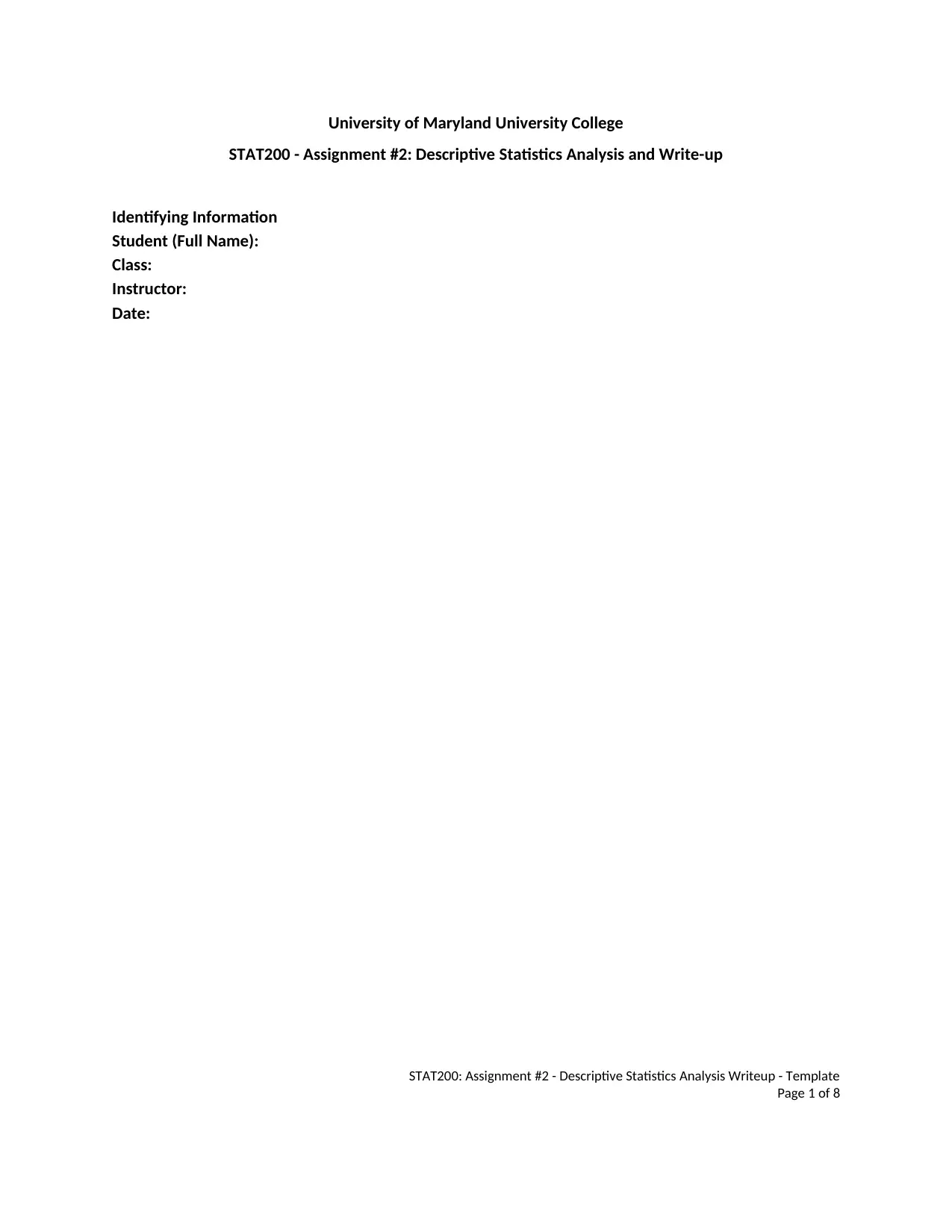
University of Maryland University College
STAT200 - Assignment #2: Descriptive Statistics Analysis and Write-up
Identifying Information
Student (Full Name):
Class:
Instructor:
Date:
STAT200: Assignment #2 - Descriptive Statistics Analysis Writeup - Template
Page 1 of 8
STAT200 - Assignment #2: Descriptive Statistics Analysis and Write-up
Identifying Information
Student (Full Name):
Class:
Instructor:
Date:
STAT200: Assignment #2 - Descriptive Statistics Analysis Writeup - Template
Page 1 of 8
Paraphrase This Document
Need a fresh take? Get an instant paraphrase of this document with our AI Paraphraser
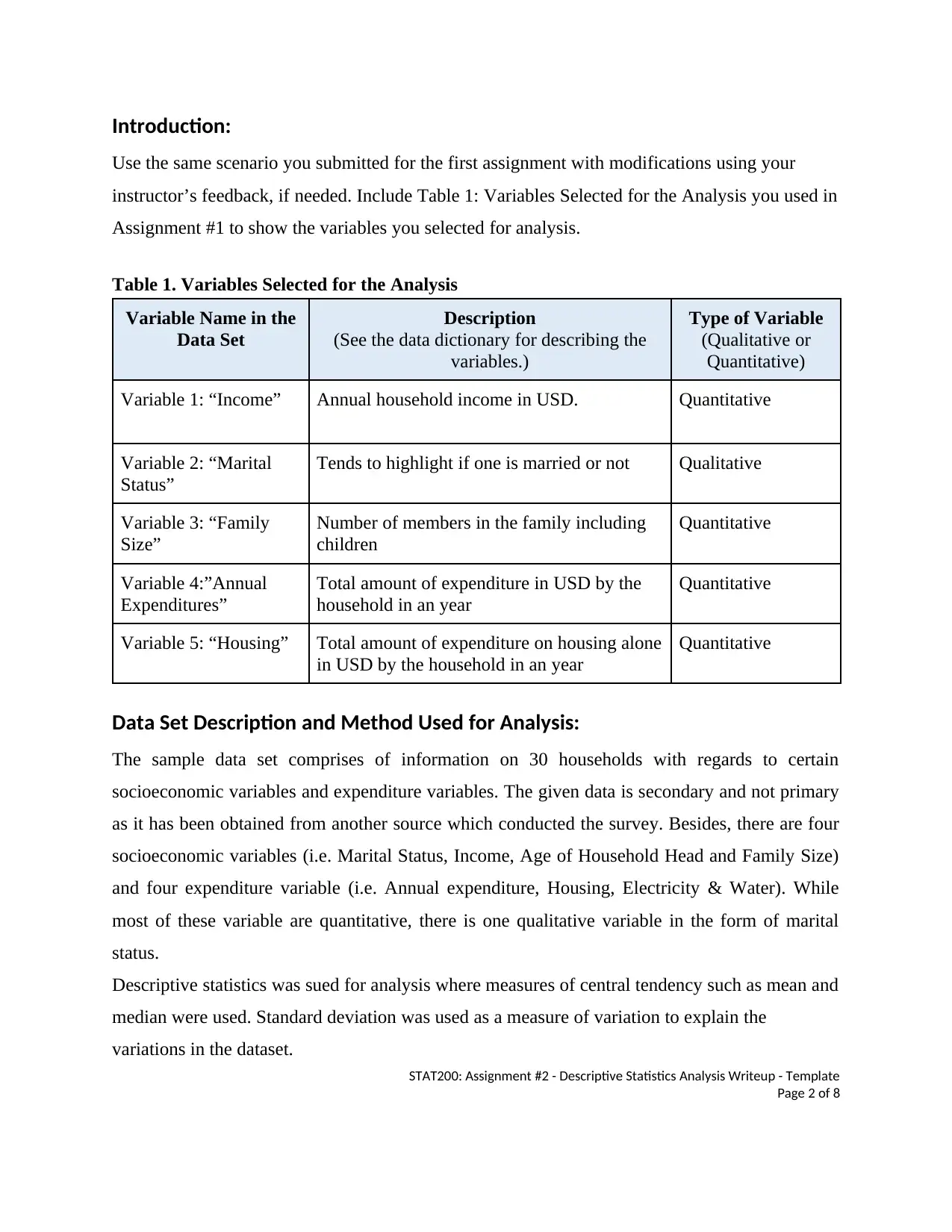
Introduction:
Use the same scenario you submitted for the first assignment with modifications using your
instructor’s feedback, if needed. Include Table 1: Variables Selected for the Analysis you used in
Assignment #1 to show the variables you selected for analysis.
Table 1. Variables Selected for the Analysis
Variable Name in the
Data Set
Description
(See the data dictionary for describing the
variables.)
Type of Variable
(Qualitative or
Quantitative)
Variable 1: “Income” Annual household income in USD. Quantitative
Variable 2: “Marital
Status”
Tends to highlight if one is married or not Qualitative
Variable 3: “Family
Size”
Number of members in the family including
children
Quantitative
Variable 4:”Annual
Expenditures”
Total amount of expenditure in USD by the
household in an year
Quantitative
Variable 5: “Housing” Total amount of expenditure on housing alone
in USD by the household in an year
Quantitative
Data Set Description and Method Used for Analysis:
The sample data set comprises of information on 30 households with regards to certain
socioeconomic variables and expenditure variables. The given data is secondary and not primary
as it has been obtained from another source which conducted the survey. Besides, there are four
socioeconomic variables (i.e. Marital Status, Income, Age of Household Head and Family Size)
and four expenditure variable (i.e. Annual expenditure, Housing, Electricity & Water). While
most of these variable are quantitative, there is one qualitative variable in the form of marital
status.
Descriptive statistics was sued for analysis where measures of central tendency such as mean and
median were used. Standard deviation was used as a measure of variation to explain the
variations in the dataset.
STAT200: Assignment #2 - Descriptive Statistics Analysis Writeup - Template
Page 2 of 8
Use the same scenario you submitted for the first assignment with modifications using your
instructor’s feedback, if needed. Include Table 1: Variables Selected for the Analysis you used in
Assignment #1 to show the variables you selected for analysis.
Table 1. Variables Selected for the Analysis
Variable Name in the
Data Set
Description
(See the data dictionary for describing the
variables.)
Type of Variable
(Qualitative or
Quantitative)
Variable 1: “Income” Annual household income in USD. Quantitative
Variable 2: “Marital
Status”
Tends to highlight if one is married or not Qualitative
Variable 3: “Family
Size”
Number of members in the family including
children
Quantitative
Variable 4:”Annual
Expenditures”
Total amount of expenditure in USD by the
household in an year
Quantitative
Variable 5: “Housing” Total amount of expenditure on housing alone
in USD by the household in an year
Quantitative
Data Set Description and Method Used for Analysis:
The sample data set comprises of information on 30 households with regards to certain
socioeconomic variables and expenditure variables. The given data is secondary and not primary
as it has been obtained from another source which conducted the survey. Besides, there are four
socioeconomic variables (i.e. Marital Status, Income, Age of Household Head and Family Size)
and four expenditure variable (i.e. Annual expenditure, Housing, Electricity & Water). While
most of these variable are quantitative, there is one qualitative variable in the form of marital
status.
Descriptive statistics was sued for analysis where measures of central tendency such as mean and
median were used. Standard deviation was used as a measure of variation to explain the
variations in the dataset.
STAT200: Assignment #2 - Descriptive Statistics Analysis Writeup - Template
Page 2 of 8

Results:
Variable 1: Income
Numerical Summary.
Table 2. Descriptive Analysis for Variable 1
Variable n Measure(s) of Central Tendency Measure(s) of Dispersion
Variable:
Income
30 Median= 96907 SD = 5516.57
Graph and/or Table: Histogram of Income
Description of Findings.
The median income was found to be 96907 with a standard deviation of 5516.57. This shows that
the data on the income is widely spread out. The histogram for the income showed that the data
is not normally distributed but rather skewed to the right.
STAT200: Assignment #2 - Descriptive Statistics Analysis Writeup - Template
Page 3 of 8
Variable 1: Income
Numerical Summary.
Table 2. Descriptive Analysis for Variable 1
Variable n Measure(s) of Central Tendency Measure(s) of Dispersion
Variable:
Income
30 Median= 96907 SD = 5516.57
Graph and/or Table: Histogram of Income
Description of Findings.
The median income was found to be 96907 with a standard deviation of 5516.57. This shows that
the data on the income is widely spread out. The histogram for the income showed that the data
is not normally distributed but rather skewed to the right.
STAT200: Assignment #2 - Descriptive Statistics Analysis Writeup - Template
Page 3 of 8
⊘ This is a preview!⊘
Do you want full access?
Subscribe today to unlock all pages.

Trusted by 1+ million students worldwide
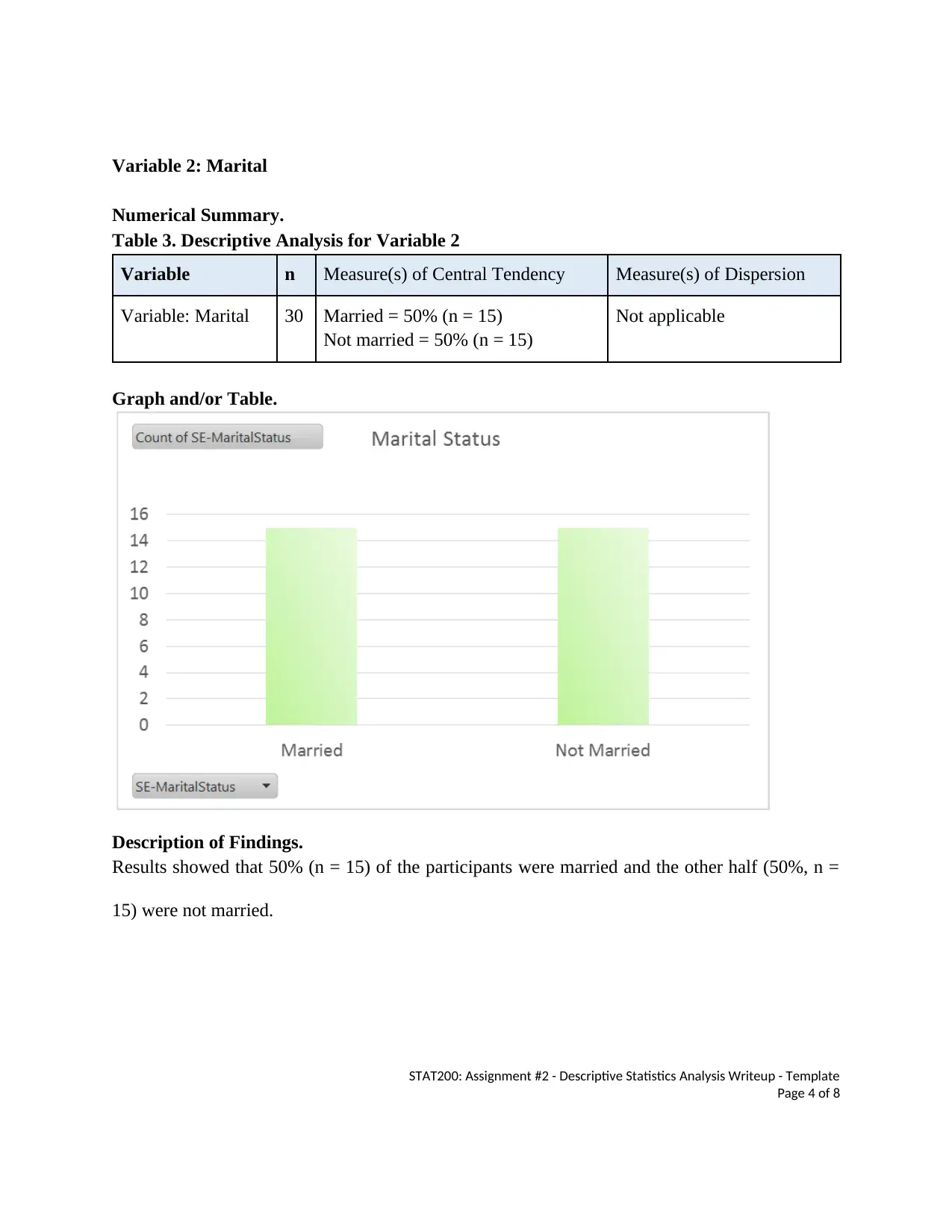
Variable 2: Marital
Numerical Summary.
Table 3. Descriptive Analysis for Variable 2
Variable n Measure(s) of Central Tendency Measure(s) of Dispersion
Variable: Marital 30 Married = 50% (n = 15)
Not married = 50% (n = 15)
Not applicable
Graph and/or Table.
Description of Findings.
Results showed that 50% (n = 15) of the participants were married and the other half (50%, n =
15) were not married.
STAT200: Assignment #2 - Descriptive Statistics Analysis Writeup - Template
Page 4 of 8
Numerical Summary.
Table 3. Descriptive Analysis for Variable 2
Variable n Measure(s) of Central Tendency Measure(s) of Dispersion
Variable: Marital 30 Married = 50% (n = 15)
Not married = 50% (n = 15)
Not applicable
Graph and/or Table.
Description of Findings.
Results showed that 50% (n = 15) of the participants were married and the other half (50%, n =
15) were not married.
STAT200: Assignment #2 - Descriptive Statistics Analysis Writeup - Template
Page 4 of 8
Paraphrase This Document
Need a fresh take? Get an instant paraphrase of this document with our AI Paraphraser
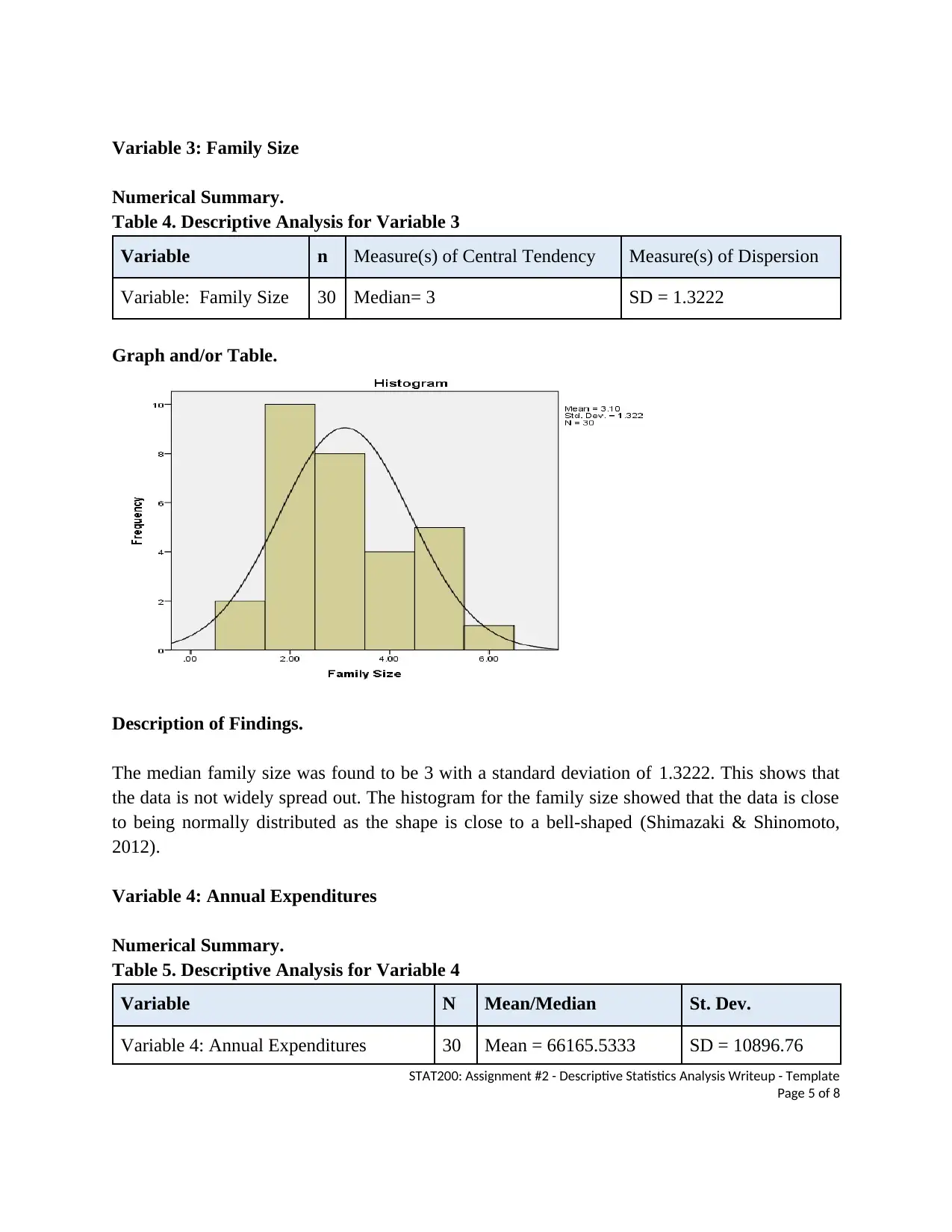
Variable 3: Family Size
Numerical Summary.
Table 4. Descriptive Analysis for Variable 3
Variable n Measure(s) of Central Tendency Measure(s) of Dispersion
Variable: Family Size 30 Median= 3 SD = 1.3222
Graph and/or Table.
Description of Findings.
The median family size was found to be 3 with a standard deviation of 1.3222. This shows that
the data is not widely spread out. The histogram for the family size showed that the data is close
to being normally distributed as the shape is close to a bell-shaped (Shimazaki & Shinomoto,
2012).
Variable 4: Annual Expenditures
Numerical Summary.
Table 5. Descriptive Analysis for Variable 4
Variable N Mean/Median St. Dev.
Variable 4: Annual Expenditures 30 Mean = 66165.5333 SD = 10896.76
STAT200: Assignment #2 - Descriptive Statistics Analysis Writeup - Template
Page 5 of 8
Numerical Summary.
Table 4. Descriptive Analysis for Variable 3
Variable n Measure(s) of Central Tendency Measure(s) of Dispersion
Variable: Family Size 30 Median= 3 SD = 1.3222
Graph and/or Table.
Description of Findings.
The median family size was found to be 3 with a standard deviation of 1.3222. This shows that
the data is not widely spread out. The histogram for the family size showed that the data is close
to being normally distributed as the shape is close to a bell-shaped (Shimazaki & Shinomoto,
2012).
Variable 4: Annual Expenditures
Numerical Summary.
Table 5. Descriptive Analysis for Variable 4
Variable N Mean/Median St. Dev.
Variable 4: Annual Expenditures 30 Mean = 66165.5333 SD = 10896.76
STAT200: Assignment #2 - Descriptive Statistics Analysis Writeup - Template
Page 5 of 8
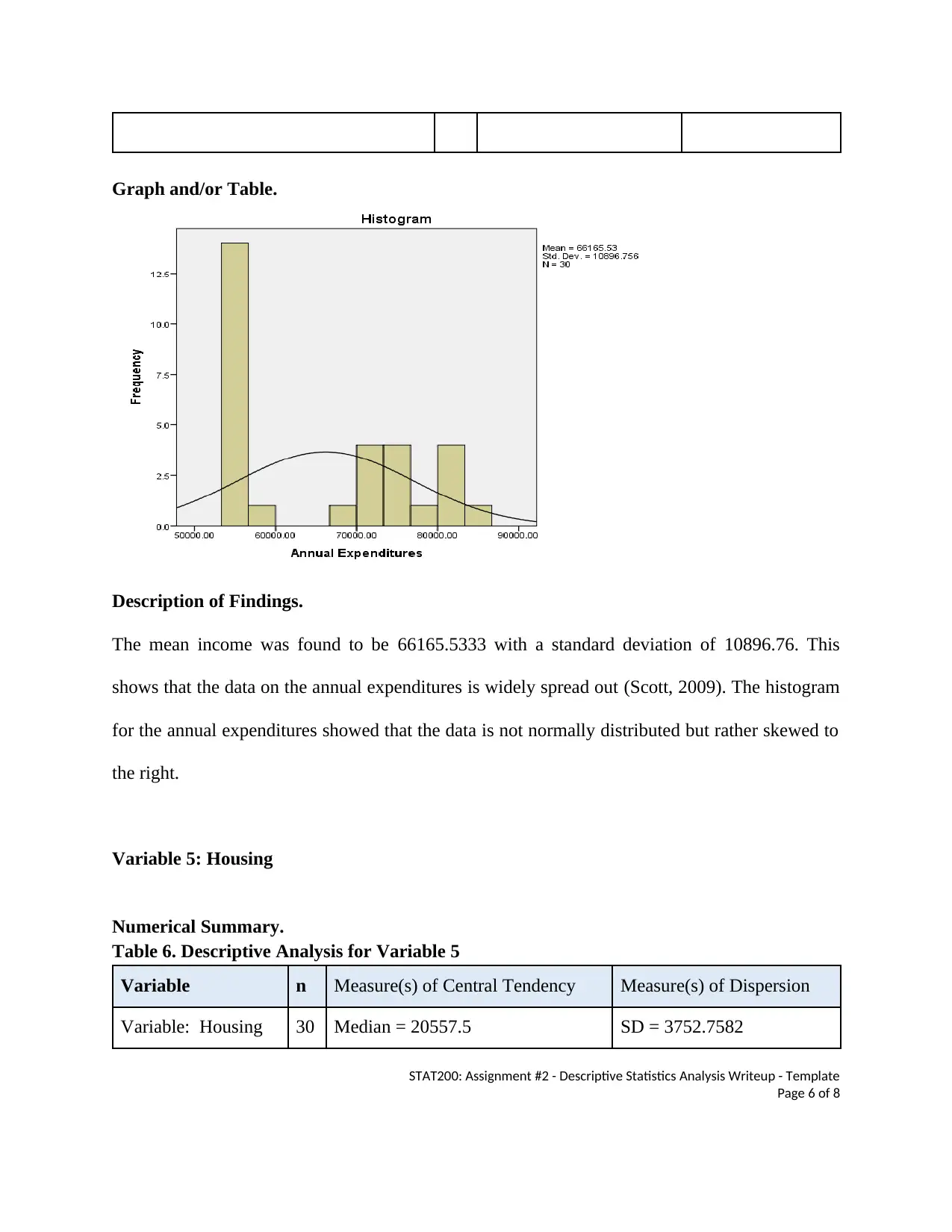
Graph and/or Table.
Description of Findings.
The mean income was found to be 66165.5333 with a standard deviation of 10896.76. This
shows that the data on the annual expenditures is widely spread out (Scott, 2009). The histogram
for the annual expenditures showed that the data is not normally distributed but rather skewed to
the right.
Variable 5: Housing
Numerical Summary.
Table 6. Descriptive Analysis for Variable 5
Variable n Measure(s) of Central Tendency Measure(s) of Dispersion
Variable: Housing 30 Median = 20557.5 SD = 3752.7582
STAT200: Assignment #2 - Descriptive Statistics Analysis Writeup - Template
Page 6 of 8
Description of Findings.
The mean income was found to be 66165.5333 with a standard deviation of 10896.76. This
shows that the data on the annual expenditures is widely spread out (Scott, 2009). The histogram
for the annual expenditures showed that the data is not normally distributed but rather skewed to
the right.
Variable 5: Housing
Numerical Summary.
Table 6. Descriptive Analysis for Variable 5
Variable n Measure(s) of Central Tendency Measure(s) of Dispersion
Variable: Housing 30 Median = 20557.5 SD = 3752.7582
STAT200: Assignment #2 - Descriptive Statistics Analysis Writeup - Template
Page 6 of 8
⊘ This is a preview!⊘
Do you want full access?
Subscribe today to unlock all pages.

Trusted by 1+ million students worldwide
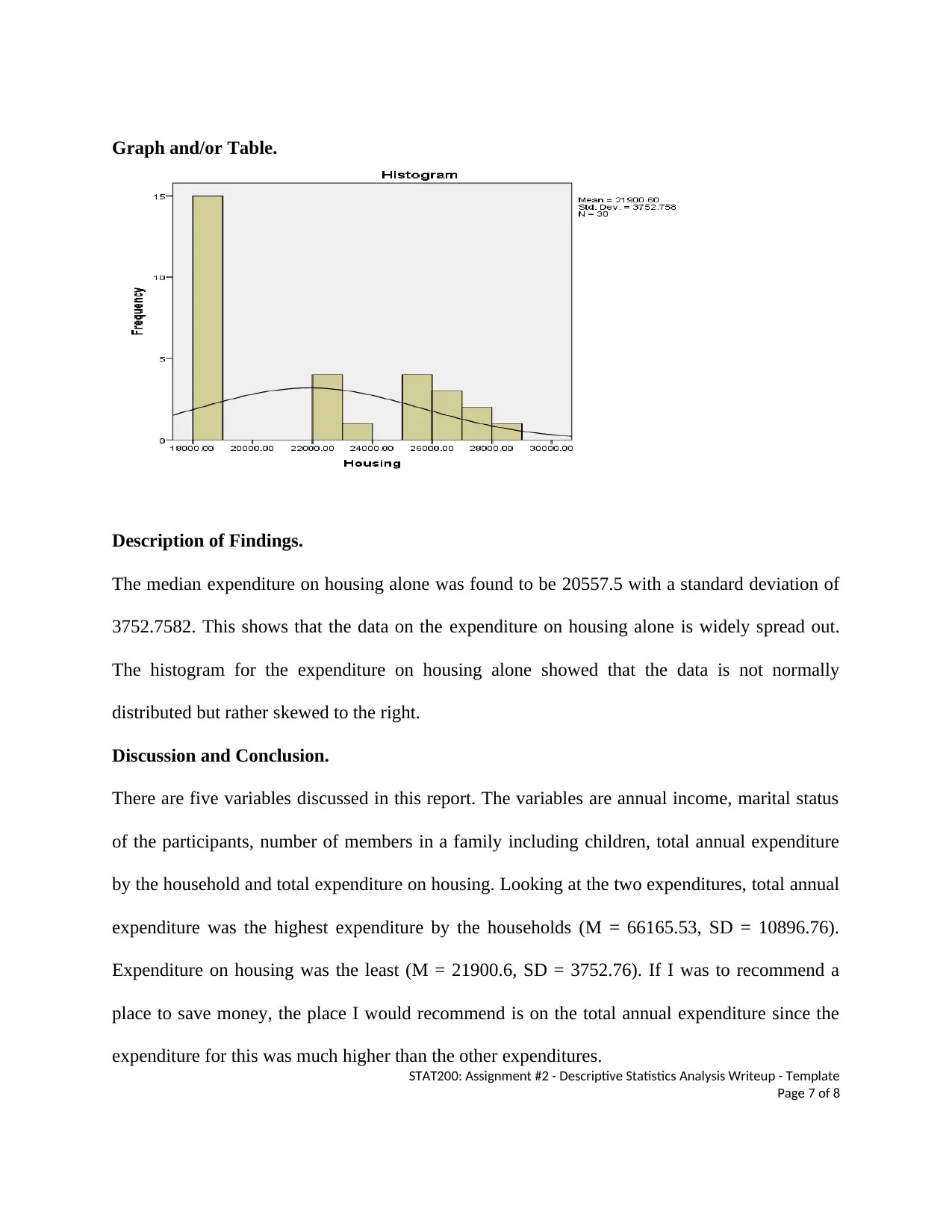
Graph and/or Table.
Description of Findings.
The median expenditure on housing alone was found to be 20557.5 with a standard deviation of
3752.7582. This shows that the data on the expenditure on housing alone is widely spread out.
The histogram for the expenditure on housing alone showed that the data is not normally
distributed but rather skewed to the right.
Discussion and Conclusion.
There are five variables discussed in this report. The variables are annual income, marital status
of the participants, number of members in a family including children, total annual expenditure
by the household and total expenditure on housing. Looking at the two expenditures, total annual
expenditure was the highest expenditure by the households (M = 66165.53, SD = 10896.76).
Expenditure on housing was the least (M = 21900.6, SD = 3752.76). If I was to recommend a
place to save money, the place I would recommend is on the total annual expenditure since the
expenditure for this was much higher than the other expenditures.
STAT200: Assignment #2 - Descriptive Statistics Analysis Writeup - Template
Page 7 of 8
Description of Findings.
The median expenditure on housing alone was found to be 20557.5 with a standard deviation of
3752.7582. This shows that the data on the expenditure on housing alone is widely spread out.
The histogram for the expenditure on housing alone showed that the data is not normally
distributed but rather skewed to the right.
Discussion and Conclusion.
There are five variables discussed in this report. The variables are annual income, marital status
of the participants, number of members in a family including children, total annual expenditure
by the household and total expenditure on housing. Looking at the two expenditures, total annual
expenditure was the highest expenditure by the households (M = 66165.53, SD = 10896.76).
Expenditure on housing was the least (M = 21900.6, SD = 3752.76). If I was to recommend a
place to save money, the place I would recommend is on the total annual expenditure since the
expenditure for this was much higher than the other expenditures.
STAT200: Assignment #2 - Descriptive Statistics Analysis Writeup - Template
Page 7 of 8
Paraphrase This Document
Need a fresh take? Get an instant paraphrase of this document with our AI Paraphraser

References
Scott, D. W. (2009). On optimal and data-based histograms. Biometrika, 66(3), 605–610.
doi:10.1093/biomet/66.3.605
Shimazaki, H., & Shinomoto, S. (2012). A method for selecting the bin size of a time histogram.
Neural Computation, 19(6), 1503–1527.
STAT200: Assignment #2 - Descriptive Statistics Analysis Writeup - Template
Page 8 of 8
Scott, D. W. (2009). On optimal and data-based histograms. Biometrika, 66(3), 605–610.
doi:10.1093/biomet/66.3.605
Shimazaki, H., & Shinomoto, S. (2012). A method for selecting the bin size of a time histogram.
Neural Computation, 19(6), 1503–1527.
STAT200: Assignment #2 - Descriptive Statistics Analysis Writeup - Template
Page 8 of 8
1 out of 8
Related Documents
Your All-in-One AI-Powered Toolkit for Academic Success.
+13062052269
info@desklib.com
Available 24*7 on WhatsApp / Email
![[object Object]](/_next/static/media/star-bottom.7253800d.svg)
Unlock your academic potential
Copyright © 2020–2025 A2Z Services. All Rights Reserved. Developed and managed by ZUCOL.




